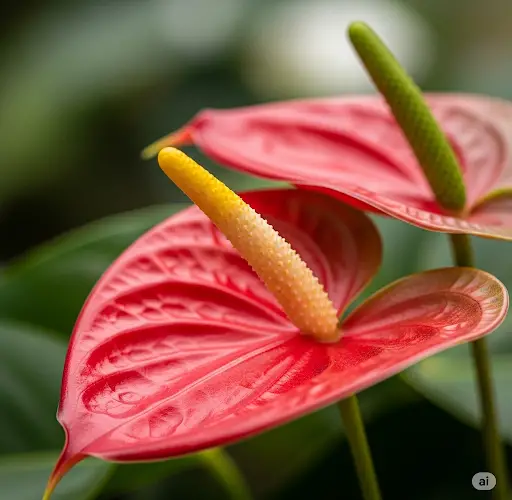Anthuriums, known for their striking waxy flowers and lush foliage, are a popular choice among houseplant lovers. But as autumn arrives, these tropical beauties often show signs of fatigue: drooping leaves, faded color, and a complete halt in blooming. Many plant owners assume their Anthurium is dying and give up on it entirely. However, with the right care and one simple autumn ritual, even the most lifeless-looking Anthurium can recover and thrive.
This method doesn’t require expensive fertilizers or rare additives—just a bit of timing, proper technique, and a powerful natural tonic that supports the plant’s recovery and encourages fresh growth and flowering.
Why Anthuriums Struggle in Autumn
Anthuriums are native to humid, tropical regions with consistent warmth and filtered light. In their natural habitat, they don’t experience seasonal shifts like we do. So when autumn brings cooler temperatures and shorter days, your Anthurium may react by slowing its metabolism, shedding leaves, and stopping flower production.
Common signs of an Anthurium struggling in autumn include:
-
Yellow or browning leaves
-
Weak or drooping stems
-
No new buds or flowers
-
Dry or compacted soil
-
Root rot due to poor drainage
The good news is that these symptoms can often be reversed with timely action and the right approach to seasonal care.
The Autumn Revival Elixir for Anthuriums
The secret to reviving your Anthurium lies in a homemade solution rich in micronutrients, plant-friendly acids, and growth stimulants. This autumn elixir supports the roots, strengthens foliage, and encourages blooming even during the off-season.
The key ingredient? Aloe vera, known for its healing properties, natural enzymes, and ability to stimulate root regeneration and leaf development. Combined with warm water and optional natural boosters like honey or a few drops of lemon juice, this solution helps “wake up” your Anthurium from its dormant state.
How to Make the Aloe-Based Autumn Tonic
Ingredients:
-
1 tablespoon of fresh aloe vera gel (or store-bought 100% aloe)
-
500 ml (about 2 cups) of lukewarm water
-
Optional: 1 teaspoon of natural honey (for added nutrients)
-
Optional: 2–3 drops of lemon juice (mild acidity improves nutrient uptake)
Instructions:
-
Blend the aloe gel with water until smooth.
-
Add honey and lemon juice if desired, and stir well.
-
Let the mixture sit at room temperature for 1–2 hours.
-
Apply directly to the base of the Anthurium as a soil drench.
Tip: For additional benefits, dip a clean cloth into the mixture and gently wipe the leaves to remove dust and deliver nutrients through foliar absorption.
How Often to Apply
Use this tonic once every 2–3 weeks during the autumn months. This allows the plant to slowly build strength and encourages flower formation without stressing the roots.
Avoid overuse. Too much moisture or nutrition can overwhelm the plant when it’s naturally slowing down. Monitor the soil between applications and ensure it remains moist but never soggy.
Additional Care Tips for Autumn Anthuriums
Alongside the tonic, proper environmental care will make a significant difference:
-
Lighting: Place your Anthurium in a spot with bright, indirect light. Autumn light is weaker, so avoid deep shade. A south- or east-facing window is ideal.
-
Humidity: Boost humidity with a room humidifier or pebble tray. Aim for 60–70% humidity to mimic tropical conditions.
-
Watering: Reduce watering slightly compared to summer. Wait until the top inch of soil feels dry before watering again.
-
Repotting: If the soil has compacted or the roots look crowded, consider repotting into fresh, well-draining orchid mix with added perlite or coconut fiber.
-
Temperature: Keep the plant away from cold drafts. Ideal temperatures range between 18–25°C (65–77°F).
What to Expect After Treatment
With consistent care and the aloe tonic, you can expect visible improvements within a few weeks:
-
New leaves may begin to form
-
Existing leaves become greener and firmer
-
Roots show signs of regeneration
-
The plant stands more upright and vibrant
-
Flower spikes may appear within 4–6 weeks (depending on light and care)
Even Anthuriums that have been neglected or appear nearly lifeless can make a strong comeback with this simple autumn intervention.
Final Thoughts
Autumn doesn’t have to signal the end of your Anthurium’s beauty. With just one natural tonic and some seasonal adjustments, your plant can remain lush, healthy, and even bloom when you least expect it. Aloe vera, a humble and accessible ingredient, provides the nourishment and stimulation your Anthurium needs to recover and shine.
Don’t throw away a struggling plant—give it the boost it needs. You might be amazed at how quickly your Anthurium transforms into a green, blooming centerpiece again, even when the days are getting shorter and cooler.


